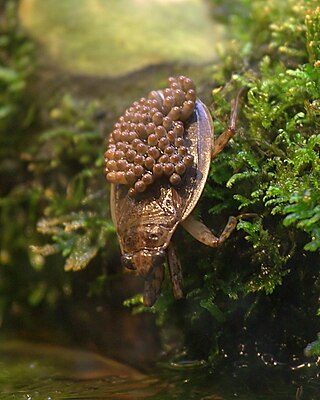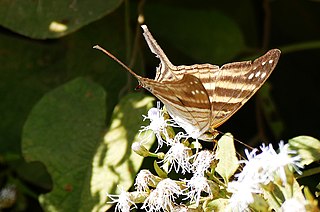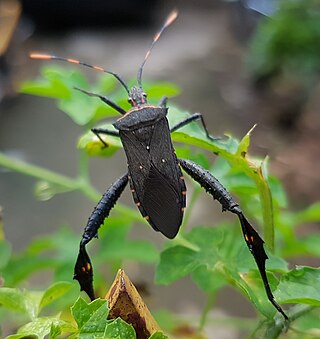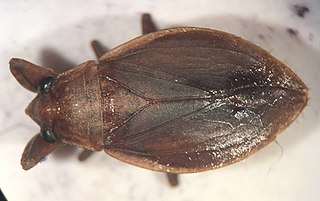
Belostomatidae is a family of freshwater hemipteran insects known as giant water bugs or colloquially as toe-biters, Indian toe-biters, electric-light bugs, alligator ticks, or alligator fleas. They are the largest insects in the order Hemiptera. There are about 170 species found in freshwater habitats worldwide, with more than 110 in the Neotropics, more than 20 in Africa, almost as many in the Nearctic, and far fewer elsewhere. These predators are typically encountered in freshwater ponds, marshes and slow-flowing streams. Most species are at least 2 cm (0.8 in) long, although smaller species, down to 0.9 cm (0.35 in), also exist. The largest are members of the genus Lethocerus, which can exceed 12 cm (4.5 in) and nearly reach the length of some of the largest beetles in the world. Giant water bugs are a popular food in parts of Asia.

Abedus is a genus of giant water bugs found in freshwater habitats in southern United States, Mexico and Central America. Sometimes called ferocious water bugs, these brown insects typically are between 2.3 and 4 cm (0.9–1.6 in) long, although A. immaculatus only is about 1.3–1.4 cm (0.51–0.55 in), making it the smallest North American belostomatid and possibly worthy of separation in its own genus. Otherwise the different Abedus species are very similar and can often only be separated with a microscope. They will bite in self-defense, which is painful but not dangerous.

Abedus herberti, the toe biter or ferocious water bug, is a species of giant water bug in the family Belostomatidae. It is native to streams, especially in highlands, in Arizona, New Mexico and Utah in the United States and in northwestern Mexico. Adults are typically 2 to 4 cm (0.8–1.6 in) long. The species is flightless, but may move overland between water sources. It will bite in self-defense, which is painful but not dangerous.

Neurocolpus nubilus, the clouded plant bug, is a species of plant bug in the family Miridae. It is found in North America.

Anasa armigera, the horned squash bug, is a species of leaf-footed bug in the family Coreidae. It is found in North America.
Cecropterus casica, the desert cloudywing, is a species of dicot skipper in the butterfly family Hesperiidae. It is found in Central America and North America.
Irbisia pacifica, the Pacific grass bug, is a species of plant bug in the family Miridae. It is found in Central America and North America.

Psallus is a genus of plant bugs in the family Miridae. There are more than 170 described species in Psallus.

Marpesia chiron, the many-banded daggerwing, is a species of daggerwings, map butterflies in the family Nymphalidae. It is found in Central America, North America, and South America.
Aradus funestus is a species of flat bug in the family Aradidae. It is found in North America.
Pilophorus tibialis is a species of plant bug in the family Miridae. It is found in Central America and North America.

Chelinidea vittiger, known generally as cactus coreid, is a species of leaf-footed bug in the family Coreidae. Other common names include the squash bug and cactus bug. It is found in Australia, Central America, and North America.
Aradus depictus is a species of flat bug in the family Aradidae. It is found in North America.
Plagiognathus maculipennis is a species of plant bug in the family Miridae. It is found in Central America and North America.
Plagiognathus brunneus is a species of plant bug in the family Miridae. It is found in North America.
Plagiognathus albatus is a species of plant bug in the family Miridae. It is found in North America.
Creontiades signatus, the verde plant bug, is a species of plant bug in the family Miridae. It is found in Central America and North America.

Rhytidoporus indentatus is a species of burrowing bug in the family Cydnidae. It is found in the Caribbean, North America, and Oceania.

Leptoglossus gonagra, known as the passionvine bug, citron bug or squash bug in different parts of its range, is a species of leaf-footed bug in the family Coreidae. It is found in Africa, the Caribbean, Central America, North America, South America, Southern Asia, the Pacific Ocean and Oceania.

Abedus immaculatus is a species of water bug in the family Belostomatidae. It is the only Abedus species found in the eastern United States, occurring throughout Florida north into Georgia and west along the Gulf Coast to Mississippi.










